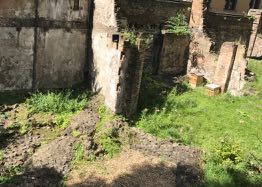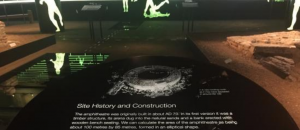On October 20, 1866, the Times of London announced that workers had pulled 20 cartloads of bones from the site around London Wall while preparing to lay the foundation for a new wool warehouse. By the time archaeologist Augustus Lane Fox arrived later the same day, most of the evidence had already been removed to the bone factory. He thought that a couple remaining piles, black from peat, could be the bones of horse or ass, and perhaps deer, boar, and goat. As he recounts in the Journal of the Anthropological Society of London, he also noted Roman tiles, red Samian pottery sherds, bronze and copper pins, knives, tweezers, and “a piece of polished metal mirror, so bright that you may see your face in it.” It must have been an amazing sight, this jumble of history brought up to the light of the present day.
I thought of this story on Sunday as we joined the Museum of London’s Roman walk around the ancient city of Londinium. We began at the ruined London Wall right outside the museum. At one time, this massive wall, constructed of an incredible 85,000 tons of ragstone, included 20 bastions and extended two miles around Londinium. Since then, it has been repurposed and rebuilt so many times that it almost seems to exist outside of regular time and space. It required a feat of imagination to look out over the modern buildings and see the site of the old Roman fort that had once stretched out over 12 acres to house around 1,000 men.

The Noble Street Wall, standing 15 feet tall and originally constructed around the late second century CE, has evidence of masonry dating from the second to the nineteenth centuries. The scarred remainder of this wall has survived various construction projects, as well as the Great Fire of London in 1666 and the Blitz. It was uncovered in 1940 after a German bombing.

Museum of London’s reconstruction of the Roman fort and the Wall
We moved on to London’s Roman amphitheater, now hidden beneath Guildhall Yard. The amphitheater was built around 70 CE and abandoned in the fourth century; the original walls and drainage system can be seen with admission to the Guildhall Art Gallery. From the street level, you might struggle to envision the games, gladiatorial contests, and public executions of the past, but it helps that the boundaries of the old amphitheater are delineated by this curved line of dark stone:

And here is the original amphitheater, as recreated at Guildhall Art Gallery:

According to our intrepid guide, a Roman temple used to sit on the site of this Pret a Manger:

We next walked to the Bloomburg London Building, which houses a Temple to Mithras in its lowest level. This Temple to Mithras, once located on the banks of the River Walbrook, was a mystery cult, open only to men and particularly popular with Roman soldiers. Bloomberg has purchased the site of the temple and is working with the Museum of London to house the temple’s remains. According to Michael Bloomberg (as quoted on bloomburg.com), “this building is designed to encourage cooperation and collaboration, and that’s what makes for a successful business.”


Bloomberg’s European headquarters; Reconstruction painting of the Temple to Mithras by Alan Sorrell from the Museum of London
We moved on to Cannon Street Station. Underneath the station are the remains of a building dating to around the late first century CE. It was an amazing structure around 140 yards long, perched above the Thames just east of the mouth of the Walbrook River. It seems to have been built around a large central garden court with a central pool.


Reconstruction painting of the so-called Governor’s Palace (c. 90 CE) by Alan Sorrell from the Museum of London
According to our guide, this Marks & Spencer marks the approximate location of the gates:

We ended our walk at Leadenhall Market, the location of the Roman Basilica and Forum:


Museum of London’s reconstruction of the Roman Basilica
The theme of our walk seemed to be that commerce and history are deeply intertwined in cosmopolitan London. All this reminds me of the controversial but approved £1.4bn plan to improve the A303 near Stonehenge with a deep-bored traffic tunnel: London is truly a rich jumble of past and present.



Great post–Thanks Monica! I’m fascinated by the uncanny resemblance between the Roman basilica and Leadenhall market built so many centuries after–and on top of–the basilica.